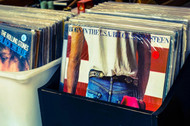Do You Have Valuable Vinyl Records?
Posted by House of Marley on Aug 26th 2022
Flipping through vinyl records might lead you to something special. Whether you inherited someone’s record collection or bought a handful of 45s from an estate sale, you’re probably wondering if there’s a “holy grail” between the sleeves.
It’s very possible. Even though most vintage records sell for under $20, valuable ones can fetch far more than the average price. For example, rare copies of The Freewheelin’ Bob Dylan that feature four unreleased songs have sold for $35,000, and you can still find them if you know what to look for.
Of course, used vinyl records that skyrocket into the five or six-figure range are few and farbetween—and often have specific characteristics that make them so valuable. But what kind of records are worth money, and how can you identify them?
We’ll show you how to assess the value of your records. Keep reading to discover if you have hidden gems in your collection!
What Kind of Vinyl Records Are Worth Money?
Vinyl records are worth money if they're rare, unique or produced by famous artists (sometimes all of the above). But there are several other factors that determine a record’s value. Here's a rundown of what to look for.
The Name of the Artist
First, you’ll need to identify which artist produced the record. Records produced by famous artists (Prince, Etta James, Stevie Wonder, Bob Marley and so on) are more collectible than lesser-known ones.
A record might be worth more if it was released before the artist became famous. Al Green’s Back Up Train, for example, was released years before his official debut. Valued at $125 for a stereo copy, it’s also one of the rarest vinyl records.
The Pressing
Record companies release several different pressings—or production runs of a record. While every pressing varies in value, first pressings are the true “diamonds in the dust.”
First pressings are made from the initial batch of lacquers (or master discs) and cut from the original master recordings. Therefore, first pressings are significantly more valuable than subsequent pressings (2nd, 3rd, 4th and so on), as well as reissues that are cut from remastered recordings.
Collectors prefer first pressings because they’re first—and it’s always cool to say you have a first edition—but many audiophiles believe first pressings offer better sound quality than subsequent pressings. Unless the first pressing had serious audio mishaps that were corrected in subsequent pressings, it’s generally accepted that first pressings have more detail because the stampers are made directly from the master disc. That’s because the stamper which presses a vinyl record wears out over time or can pick up scratches and flaws. The earlier the pressing, the purer the sound.
Age
Records from popular eras are usually more in-demand than others. You can identify your record’s age by reading the liner notes—the text printed on the sleeve.
Vinyl records from the ‘50s and ‘60s are very collectible. These records are from the “golden era” of the vinyl record timeline, made famous by the greatest musicians in history—The Beatles, Jimi Hendrix, James Brown and Bob Dylan to name a few.
Old 78 RPM records from the ‘20s can also be collectible. These records feature the earliest recordings of American jazz, blues and rock n’ roll. Rare examples, like Elvis Presley's “That’s Alright / Blue Moon of Kentucky,” have sold for thousands of dollars.
However, there’s a common misconception that vintage always means valuable. Although older records are more desirable, many vintage records sell for less than $5. That’s because there are other factors, such as condition and rarity, that also affect value.
Condition
A vintage record is like a well-loved book, from the crisp smell of yellowed paper to the crackling sound of its worn spine. But despite these lovable characteristics, records in bad condition are always worth less than ones in good condition.
A record’s condition ranges from poor (P) to mint (M). Vinyl records rated closer toward the “mint” side of the scale earn a higher rating than records with scratches, warpage, torn labels or groove wear.
You can grade your records at home using the Goldmine Grading Guide. If your records have a high grade—Very Good+ or Near Mint for instance—they can exceed the average price.
Rarity
A record is considered rare when there are very few copies in circulation. While major albums were traditionally mass-produced, some pressings were released in smaller batches. Many out-of-print records, picture discs, imports and limited-edition records occasionally fall into this category.
Some records are rare because they were destroyed or removed from the market. For instance, all 500,000 copies of Prince’s, The Black Album, were ordered to be destroyed just days before the album was due to be released—but a few copies landed in the hands of fans as many had already been shipped to record stores. Though it’s since been reissued, original versions of The Black Album can be sold for over $10,000.
Even rare reissues can fetch a ridiculously high price. The blue reissued copy of David Bowie’s The Next Day was limited to 50 numbered copies worldwide. Resale value starts at roughly $4,500 and can easily exceed $10,000.
Uniqueness
There are several factors that make a vinyl record unique, including autographs, test pressings and more. Keep your eyes open for records that have any of the characteristics listed below.
-
Autographed - Autographed vinyl records are precious. If your record is signed by all the members of a band, the value may increase substantially. Even better if you have a certificate of authenticity.
-
Sealed - A sealed vinyl record is still in its original shrink wrap. These records are almost always in mint condition and have never been played. Assuming the album cover hasn’t suffered any damage and the records were stored properly, it could be worth significantly more than an opened copy.
-
Limited Edition - Limited edition records are pressed in smaller runs that range between a few hundred to a few thousand copies. They sometimes include exclusive artwork, album inserts, memorabilia, bonus tracks, colored vinyl discs and more.
-
Promo Copies - If you find a promo copy, there’s a chance you’ll see a slight increase in value. Traditionally, promo vinyl records were pressed in small numbers and sent to radio stations for promotional airplay. Aside from a “promo only” sticker, or a hole-punched cover, they’re usually identical to the retail copies.
-
Colored Vinyl - Record companies began releasing colored vinyl records to grab the attention of radio DJs in the ‘60s. Colored pressings, like the translucent blue copy of Pink Floyd’s Wish You Were Here, are very valuable. Other examples, like the yellow copy of Soul Rebel by Bob Marley and The Wailers, are popular among music lovers who prefer colored variants of classic LPs.
-
Picture Discs - Picture discs feature artwork on one or both sides of a record. These eye-catching records became popular during the ‘70s and ‘80s. In addition to being visually stunning, picture discs are harder to find.
-
Imports - Imports are records pressed for a foreign country. Sometimes these records feature artwork or labels that are different from the original pressing. Imports were usually pressed in smaller runs, so their scarcity makes them more valuable.
-
Test Pressings - Test pressings allow the artist and label to inspect the quality of an album before thousands of copies are pressed. Like promo copies, these records are neither distributed to stores nor sold to the public.
How Do I Know if My Vinyl Records Are Valuable?
You can tell if your records are valuable by researching online databases, hiring experts or speaking with a record store. Below you’ll find a deeper explanation of each method.
Discogs
Discogs has information on 14 million music releases dating back to the 1800s. With a quick search, you can find a detailed price range for every record in your collection.
Begin by entering your record’s catalog number in the Discog’s database. You can find the catalog number on the album cover, on the label or etched into the center of the record. Type the catalog number into the Discogs “Search” box to locate the exact pressing you own.
Under the “Marketplace” tab, you can get a short summary of the record’s sale history. This feature shows the record’s lowest, median and highest price values on the Discogs Marketplace. You can also click “Buy Now” to compare the prices that record stores and private sellers are currently listing.
Discogs can also estimate the price range of your entire collection. You can ask Discogs to provide an excel spreadsheet of the pricing data for free—a useful point of reference if you’re selling records in bulk.
Hire an Appraiser
Hiring a professional appraiser is a good option if you’re auctioning your records or selling an entire collection to a record store. Though online appraisal services are available, we recommend finding a local professional who specializes in vinyl records.
Appraisers charge a fee that varies depending on how many records you have. For instance, appraisers request a higher fee for large collections and onsite appraisals. Getting a small crate of records appraised, however, will be easier on your wallet.
A friendly word of advice—find a reputable appraisal service! Always do your research and explore your options before making the decision to hire an appraiser.
Visit a Record Store
When you’re scratching your head, trying to identify which pressing you own, pay a visit to your local record store. Naturally, record store staff members have the knowledge and experience to grade your records—and they can identify a hidden gem in seconds.
Record store staff members have their fingers on the pulse of the used record market. And whether they’re buying used records for the shop or grading an entire record collection, they always keep an eye open for hidden gems.
With help from a friendly staff member, you’ll get a better understanding of how much your records are worth. And if you decide to sell that “holy grail,” the shop will offer you an honest price.













